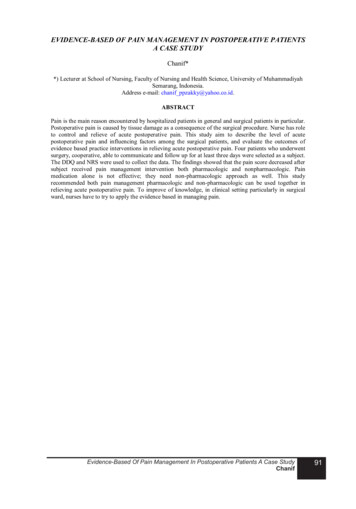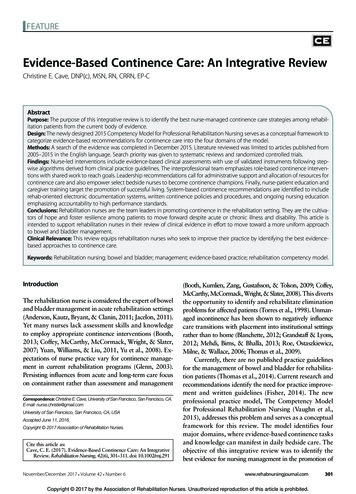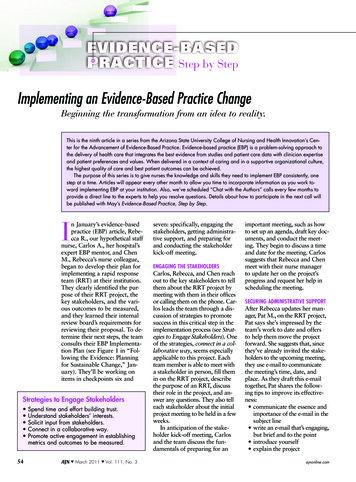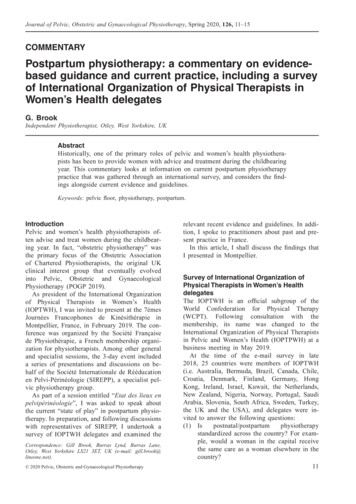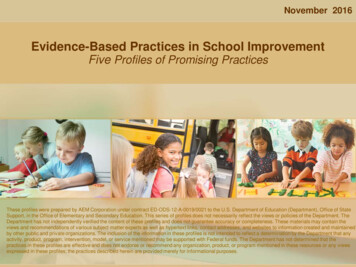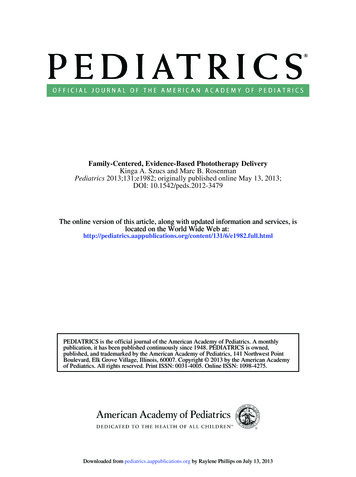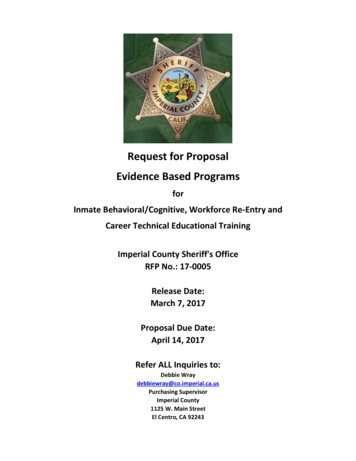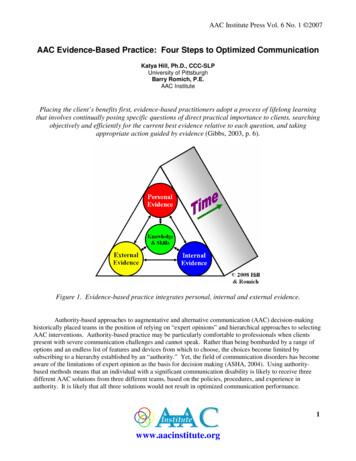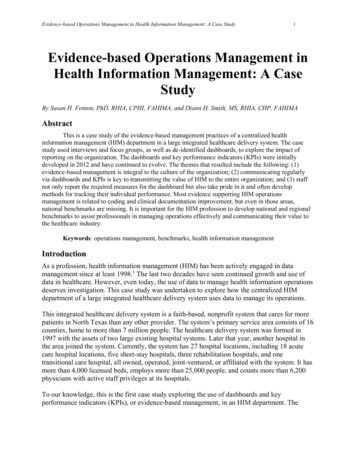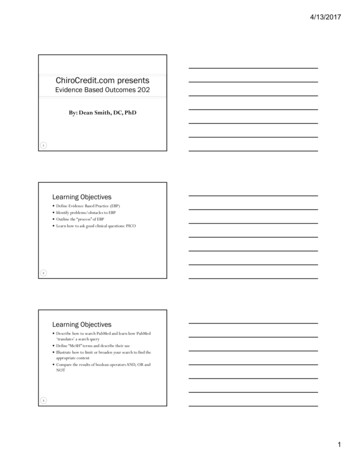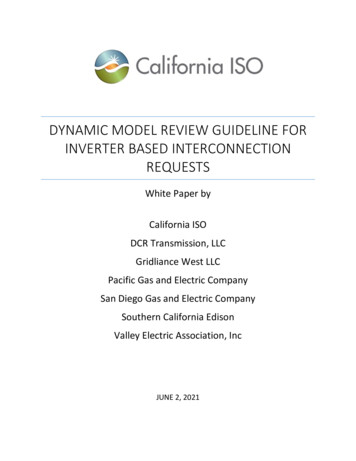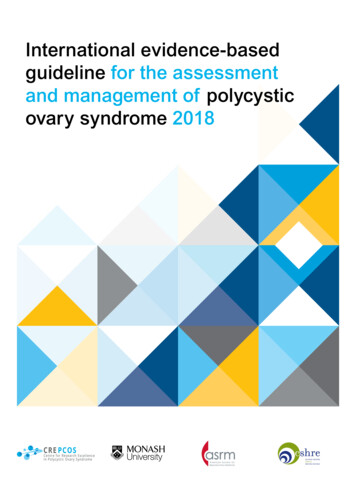
Transcription
International evidence-basedguideline for the assessmentand management of polycysticovary syndrome 2018
Publication approvalPublication historyOriginal version 2011 –(National PCOS guideline)The guideline recommendations on pages 16 to 34 of this document wereapproved by the Chief Executive Officer of the National Health and MedicalResearch Council (NHMRC) on 2 July 2018 under section 14A of the NationalHealth and Medical Research Council Act 1992. In approving the guidelinerecommendations, NHMRC considers that they meet the NHMRC standardfor clinical practice guidelines. This approval is valid for a period of five years.NHMRC is satisfied that the guideline recommendations are systematicallyderived, based on the identification and synthesis of the best availablescientific evidence, and developed for health professionals practisingin an Australian health care setting.This publication reflects the views of the authors and not necessarilythe views of the Australian Government.Updated version August 2015 –Aromatase inhibitors section updateUpdated, expanded and internationalcurrent version February 2018AuthorshipThis guideline was authored by Helena Teede,Marie Misso, Michael Costello, Anuja Dokras,Joop Laven, Lisa Moran, Terhi Piltonen andRobert Norman on behalf of the InternationalPCOS Network in collaboration with funding,partner and collaborating organisations,see Acknowledgments.DisclaimerCopyright informationThe Centre for Research Excellence in Polycystic Ovary Syndrome(CREPCOS) research in partnership with the European Society ofHuman Reproduction and Embryology (ESHRE) and American Societyof Reproductive Medicine (ASRM), and in collaboration with professionalsocieties and consumer advocacy groups internationally, developed theevidence-based guideline to provide evidence-based recommendationsto improve the quality of healthcare, health outcomes and quality of life ofwomen with PCOS. The guideline represents the integration of the bestevidence available at the time of preparation, multidisciplinary, internationalclinical perspectives and patient preferences. In the absence of scientificevidence in PCOS, evidence from the general population was considered anda consensus between the engaged stakeholders was obtained. Monash University on behalf of the NHMRC,Centre for Research Excellence in PCOS andthe Australian PCOS Alliance 2018.The aim of evidenced-based guideline is to aid healthcare professionalsand consumers in decisions about appropriate and effective care, althoughrecommendations are generalised and application requires consideration ofindividual patient characteristics and preferences. All recommendations andpractice points need to be considered in the context of regional regulations.Adherence to the guideline does not guarantee a successful or specificoutcome in an individual or override the healthcare professional’s clinicaljudgment or patient preference in diagnosis and treatment of individualpatients. Ultimately, healthcare professionals must make their own clinicaldecisions on a case-by-case basis, using their clinical judgment, knowledge,and expertise, and taking into account the condition, circumstances, andperspectives of the individual patient, in consultation with that patient and/orthe guardian or carer.The guideline partners make no warranty, express or implied, regarding theguideline and specifically excludes any warranties of merchantability andfitness for a particular use or purpose. The partners shall not be liable fordirect, indirect, special, incidental, or consequential damages related to theuse of the information contained herein. While the partners have made everyeffort to compile accurate current information, however we cannot guaranteethe correctness, completeness, and accuracy of the guideline in every respectat all times. Guidelines do not necessarily represent the views of all cliniciansthat are members of the partner and collaborating societies. The informationprovided in this document does not constitute business, medical or otherprofessional advice, and is subject to change.Paper-based publication: This work iscopyright. Apart from any use permitted under theCopyright Act 1968, no part may be reproducedby any process without written permission fromMonash University MCHRI-PCOS-GuidelineGroup-l@monash.edu. Elements of this guidelinewere updated from the 2011 PCOS guideline andare included here with permission from theJean Hailes Foundation for Women’s Health.ISBN-13:978-0-646-98332-5Electronic documents: This work is copyright.You may download, display, print and reproducethis material in unaltered form only (retaining thisnotice) for your personal, non-commercial use,or use within your organisation. Apart from anyuse as permitted under the Copyright Act 1968,all other rights are reserved.Copies of the guideline can be downloaded frommonash.edu/medicine/sphpm/mchri/pcos.Suggested citation: International evidencebased guideline for the assessment andmanagement of polycystic ovary syndrome.Copyright Monash University,Melbourne Australia 2018.
AcknowledgmentsWe gratefully acknowledge the contribution of our engaged, funding, partner and collaborating organisations:1 The Australian National Health and Medical Research Council (NHMRC) through the funded Centre for ResearchExcellence in Polycystic Ovary Syndrome (CREPCOS) (APP1078444) and the members of this Centre who ledand co-ordinated this international guideline effort2 Our partner organisations which co-funded the guideline: American Society for Reproductive Medicine (ASRM) European Society of Human Reproduction and Embryology (ESHRE)3 Our collaborating and engaged societies and consumer groups: Androgen Excess and Polycystic Ovary Syndrome Society (AEPCOS) American Paediatric Endocrine Society Asia Pacific Paediatric Endocrine Society (APPES) Asia Pacific Initiative on Reproduction (ASPIRE) Australasian Paediatric Endocrine Group (APEG) Australian Diabetes Society (ADS) British Fertility Society (BFS) Canadian Society of Endocrinology and Metabolism (CSEM) Dietitians Association Australia (DAA) Endocrine Society (US Endo) Endocrine Society Australia (ESA) European Society of Endocrinology (ESE) European Society for Paediatric Endocrinology (ESPE) Exercise and Sports Science Australia (ESSA) Federation of Obstetric and Gynaecological Societies of India (FOGSI) Fertility Society Australia (FSA) International Society of Endocrinology (ISE) International Federation of Fertility Societies (IFFS) International Federation of Gynaecology and Obstetrics (FIGO) Italian Society of Gynaecology and Obstetrics (SIGO) Japanese Society for Paediatric Endocrinology (JSPE) Jean Hailes for Women's Health (Translation partner) Latin American Society for Paediatric Endocrinology (SLEP) Nordic Federation of Societies of Obstetrics and Gynaecology (NFOG) PCOS Challenge Inc: The National Polycystic Ovary Syndrome Association The PCOS Society (India) Paediatric Endocrine Society (PES) Polycystic Ovary Syndrome Association of Australia (POSAA) Royal Australasian College of Physicians (RACP) Royal Australian College of General Practitioners (RACGP) Royal Australian and New Zealand College of Obstetricians and Gynaecologists (RANZCOG) Royal College of Obstetricians and Gynaecologists (RCOG) Society for Endocrinology (United Kingdom) South African Society of Gynaecology and Obstetrics (SASOG) Verity UK Victorian Assisted Reproductive Technology Association (VARTA)Other relevant organisations are welcome to partner in guideline translation once approved.International evidence-based guideline for the assessment and management of polycystic ovary syndrome 20181CONTENTS
ContentsPublication approvalPublication historyScreening, diagnostic assessment,risk assessment and life-stage35Disclaimer1.1Irregular cycles and ovulatory dysfunction36Authorship1.2Biochemical hyperandrogenism38Copyright information1.3Clinical hyperandrogenism401.4Ultrasound and polycystic ovarian morphology421.5Anti-Müllerian Hormone (AMH)451.6Ethnic variation461.7Menopause life-stage471.8Cardiovascular disease481.9Gestational diabetes, impaired glucosetolerance and type 2 t5Executive Summary6Context and background6Guideline purpose and aims7Key principles8Patient population8Setting and audience8Governance8Guideline Development Groups10Prioritised clinical questions10What the guideline does not address10Guideline development methods10Community and consumer engagement11Funding12Editorial independence and disclosures of interest12Guideline translation12Interpreting the recommendations14Recommendations Summary16Chapter One2CONTENTS1.10 Obstructive sleep apnea531.11 Endometrial cancer55Chapter TwoPrevalence, screening, diagnostic assessmentand treatment of emotional wellbeing572.1Quality of life582.2Depressive and anxiety symptoms,screening and treatment602.3Psychosexual function632.4Body image652.5Eating disorders and disordered eating672.6Information resources, models of care,cultural and linguistic considerations69Chapter ThreeLifestyle723.1Effectiveness of lifestyle interventions733.2Behavioural interventions753.3Dietary interventions773.4Exercise interventions793.5Obesity and weight assessment82
Chapter FourPharmacological treatment for non-fertility indications 84Chapter SixGuideline development methods1244.1Pharmacological treatment principles in PCOSGovernance and process1254.2&4.3Combined Oral Contraceptive Pills andcombined oral contraceptive pills incombination with other agentsMultidisciplinary international guidelinedevelopment groups12586Clinical question development and prioritisation1264.4Metformin91Outcome prioritisation using the GRADE method1294.5Anti-obesity pharmacological agents95Adaptation of existing evidence-based guidelines1304.6Anti-androgen pharmacological agents97Evidence reviews to answer the clinical questions1304.7Inositol99Quality (certainty) of the body of evidenceusing GRADE evidence profiles133Formulation of recommendations usingthe GRADE evidence to decision framework134Public consultation136Chapter FiveAssessment and treatment of infertility851005.1a Assessment of factors that may affect fertility,treatment response or pregnancy outcomes1015.1b Tubal patency testing103External review1365.2Ovulation induction principles104Scheduled review and update of the guideline1365.3Letrozole105Dissemination and implementation1375.4Clomiphene citrate and/or dix I:Project board1735.6Anti-obesity agents112Appendix II: International Advisory Panel1745.7Laparoscopic ovarian surgery113Appendix III: Guideline development groups1755.8Bariatric surgery115Guideline development technical team members1805.9a In-vitro fertilisation117Paediatric GDG panel membership1805.9b Gonadotropin releasing hormone protocol118Appendix IV: Berlin Questionnaire 1997 IONSLEEP1815.9c Trigger type119Appendix V: Abbreviations and acronyms1825.9d Choice of FSH120Appendix VI: Glossary1835.9e Exogenous luteinizing hormone (LH)1215.9fAdjunct metformin122Appendix VII: Evidence-based guidelinedevelopment pathway1885.9g In-vitro maturation123Appendix VIII:190Algorithm 1: Screening, diagnostic assessment,risk assessment and life-stage191Algorithm 2: Prevalence, screening,diagnostic assessment andtreatment of emotional wellbeing193Algorithm 3: Lifestyle194Algorithm 4: Pharmacological treatment fornon-fertility indications195Algorithm 5: Assessment and treatment of infertility 196International evidence-based guideline for the assessment and management of polycystic ovary syndrome 20183CONTENTS
PrefaceThis International evidence-based guideline for the assessment and management of Polycystic Ovary Syndrome(PCOS), designed to provide clear information to assist clinical decision making and support optimal patient care, isthe culmination of the work of over 3000 health professionals and consumers internationally. The vast majority gaveof their time and expertise voluntarily. We fully appreciate the considerable contributions of the guideline developmentgroup members and particularly of the project board (Appendix I), international advisory board (Appendix II) and mostimportantly to the chairs, co-chairs and members of the international, multidisciplinary guideline development groups(Appendix III).Acknowledgement goes to the tireless efforts, commitment, dedication and drive of the Project Manager, Ms LindaDownes, Evidence lead Dr Marie Misso, Translation lead Dr Rhonda Garad, Project Board Chair, Professor RobertNorman, and the guideline evidence team for their contribution. We acknowledge the enthusiasm and engagementof the health professionals and women affected by PCOS, our partners European Society of Human Reproductionand Embryology and American Society for Reproductive Medicine and our collaborating and engaged professionalsocieties and consumer advocacy and support organisations internationally. These stakeholders have guided scope,identification of gaps and needs, prioritisation of clinical questions and outcomes of importance, review of evidence,formulations of recommendations and the guideline, as well as development and implementationof the dissemination and translation program.Professor Helena Teede MBBS, PhD, FRACP, FAAHMS.Director, National Health and Medical Research Council Centre of Excellencein PCOS International PCOS Guideline leadDirector, Monash Centre for Health Research and Implementation (MCHRI),Monash Public Health and Medicine, Monash UniversityExecutive Director, Monash Partners Academic Health Sciences CentreEndocrinologist, Monash Health4CONTENTS
AbstractObjective: To develop and translate rigorous, comprehensive evidence-based diagnosis, assessment and treatmentguidelines, to improve the lives of women with polycystic ovary syndrome (PCOS) worldwide.Participants: Extensive health professional and patient engagement informed guideline priority areas. InternationalSociety-nominated panels included consumers, paediatrics, endocrinology, gynaecology, primary care, reproductiveendocrinology, psychiatry, psychology, dietetics, exercise physiology, public health, project management, evidencesynthesis and translation experts.Evidence: Best practice evidence-based guideline development involved extensive evidence synthesis and the Gradingof Recommendations, Assessment, Development, and Evaluation (GRADE) framework covered evidence quality,feasibility, acceptability, cost, implementation and ultimately recommendation strength.Process: Governance included an international advisory board from six continents, a project board, five guidelinedevelopment groups with 63 members, consumer and translation committees. The Australian Centre for ResearchExcellence in PCOS, funded by the National Health and Medical Research Council (NHMRC), partnered withEuropean Society of Human Reproduction and Embryology and the American Society for Reproductive Medicine.Thirty seven organisations across 71 countries collaborated with 23 face to face international meetings over15 months. Sixty prioritised clinical questions involved 40 systematic and 20 narrative reviews, generating166 recommendations and practice points. Convened Committees from partner and collaborating organisationsprovided peer review and the guideline was approved by the NHMRC.Conclusions: We endorse the Rotterdam PCOS diagnostic criteria in adults (two of clinical or biochemicalhyperandrogenism, ovulatory dysfunction, or polycystic ovaries on ultrasound) and where irregular menstrual cyclesand hyperandrogenism are present, highlight that ultrasound is not necessary in diagnosis. Within eight years ofmenarche, both hyperandrogenism and ovulatory dysfunction are required, with ultrasound not recommended.Ultrasound criteria are tightened with advancing technology. Anti-Müllerian hormone levels are not yet adequatefor diagnosis. Once diagnosed, assessment and management includes reproductive, metabolic and psychologicalfeatures. Education, self-empowerment, multidisciplinary care and lifestyle intervention for prevention or managementof excess weight are important. Depressive and anxiety symptoms should be screened, assessed and managedwith the need for awareness of other impacts on emotional wellbeing. Combined oral contraceptive pills are firstline pharmacological management for menstrual irregularity and hyperandrogenism, with no specific recommendedpreparations and general preference for lower dose preparations. Metformin is recommended in addition or alone,primarily for metabolic features. Letrozole is first-line pharmacological infertility therapy; with clomiphene andmetformin having a role alone and in combination. In women with PCOS and anovulatory infertility, gonadotrophinsare second line. In the absence of an absolute indication for IVF, women with PCOS and anovulatory infertility, couldbe offered IVF third line where other ovulation induction therapies have failed. Overall evidence is low to moderatequality, requiring significant research expansion in this neglected, yet common condition. Guideline translation will beextensive including a multilingual patient mobile application and health professional training.International evidence-based guideline for the assessment and management of polycystic ovary syndrome 20185CONTENTS
ExecutiveSummaryThis international guideline and translation program addresses health professional andconsumer priorities. The guideline integrates the best available evidence with international,multidisciplinary clinical expertise and consumer preferences to provide health professionals,consumers and policy makers with guidance. The guideline and translation program promoteaccurate and timely diagnosis and optimal and consistent assessment and treatment ofpolycystic ovary syndrome (PCOS), with prevention of complications and improved patientexperience and health outcomes for the one in ten women worldwide with PCOS.Context and backgroundPolycystic ovary syndrome (PCOS) is a significant public health issue with reproductive, metabolicand psychological features. PCOS is one of the most common conditions in reproductive aged women affecting8-13% of reproductive-aged women [1-4] with up to 70% of affected women remaining undiagnosed [3]. Presentationvaries by ethnicity and in high-risk populations such as Indigenous women, prevalence and complications are higher[4, 5]. Women with PCOS present with diverse features including psychological (anxiety, depression, body image) [6-8],reproductive (irregular menstrual cycles, hirsutism, infertility and pregnancy complications) [9] and metabolic features(insulin resistance (IR), metabolic syndrome, prediabetes, type 2 diabetes (DM2) and cardiovascular risk factors) [10, 11].Diagnosis and treatment of PCOS remain controversial with challenges defining individual components within thediagnostic criteria, significant clinical heterogeneity generating a range of phenotypes with or without obesity, ethnicdifferences and variation in clinical features across the life course. These factors contribute to variation in diagnosisand care across geographical regions and health professional groups [12]. This culminates in delayed diagnosis,poor diagnosis experience and dissatisfaction with care reported by women internationally [13]. These challenges areexacerbated by a lack of recognition of the diverse features of PCOS, inadequate funding for quality research and alack of comprehensive international evidence-based guidelines [14]. In this context, there was a compelling need fordevelopment and translation of an international evidence-based guideline for assessment and management of PCOS,addressing psychological, metabolic and reproductive features of PCOS, promoting consistent evidence-based careand guiding and encouraging research in PCOS.The extensive international guideline network across our partners and collaborators engaged in prioritisation of clinicalquestions and outcomes, identification of gaps in knowledge and care and into translation preferences and informationneeds for health professionals and consumers. This stakeholder engagement directly informed the guideline andtranslation program and involved over 3000 health professionals and consumers with PCOS. Our partners andcollaborators contributed members to the guideline governance, development and translation committees. Theyformed special interest groups with considerable expertise in PCOS to provide feedback during the public consultationprocess and are engaged in translation and evaluation. Partners and collaborators have agreed that the NationalHealth and Medical Research Council (NHMRC) is the single approving body for the guideline.6CONTENTS
Governance included international representation across the Advisory Committee, Project Board, Consumer ReferenceGroup, Translation Committee and five multidisciplinary Guideline Development Groups comprising partner and collaboratornominated experts, practising clinicians and consumers (Figure 1, Figure 2 and Appendix I-III). Guideline developmentgroups and special interest groups/experts were nominated by the partner and collaborator organisations. The AustralianCentre for Research Excellence in PCOS (CREPCOS), funded by the National Health and Medical Research Council(NHMRC), led and primarily funded the guideline development. In this endeavour, we partnered with the European Societyof Human Reproduction and Embryology (ESHRE) and the American Society for Reproductive Medicine (ASRM) to fundand complete the guideline.Guideline development engagement and processes were extensive and followed best practice. Four project boardand 15 guideline development group face to face meetings occurred across Europe, USA and Australia over 15months, and enabled training, guideline development and informed translation. Sixty prioritised clinical questions wereaddressed with 40 systematic and 20 narrative reviews, generating 166 recommendations and practice points.International best practice comprehensive methods for evidence review and guideline development were applied,aligned with the NHMRC and ESHRE requirements. A highly experienced team undertook evidence synthesis witha focus on study designs least susceptible to bias; a priori criteria for inclusion and appraisal of studies, stakeholderprioritised clinical questions and outcome measures, extraction of study data; quality appraisal and meta-analysiswhere appropriate. Recommendations were formulated using the considered judgement process in the Gradingof Recommendations, Assessment, Development, and Evaluation (GRADE) framework [15] across the qualityof available evidence, integrating clinical expertise and consumer preference, and considering the applicability,feasibility, equity, cost effectiveness, implementation and value for consumers and health professionals through theGRADE framework. Implementation issues and international health systems and settings were also considered.Special interest groups of world experts and affected women were formulated to review and provide feedback on theguideline, with subsequent refinement and guideline development group approval. The guideline was then appraisedindependently by independent evidence synthesis experts and submitted to NHMRC for consideration of approval.Guideline purpose and aimsThe purpose of this international evidence-based guideline is to integrate the best available evidence with multidisciplinaryexpertise and consumer preferences to provide health professionals, consumers and policy makers with transparentevidence-based guidance on timely diagnosis, accurate assessment and optimal treatment of PCOS, to reduce variationin care, optimise prevention of complications and improve health outcomes.The guideline aims to ensure that women with PCOS receive optimal, evidence-based care by: engaging multidisciplinary international expert representation in PCOS care nominated by partner and collaboratorsocieties;including international consumer and primary care representatives;following rigorous Appraisal of Guidelines for Research and Evaluation (AGREE) II-compliant evidence-basedguideline processes;developing an international comprehensive guideline on diagnosis, assessment and management of PCOS;providing a single source of international evidence-based recommendations to guide clinical practice and reducevariation worldwide, with the opportunity for adaptation in relevant health systems as needed;providing a basis for improving patient outcomes;identifying knowledge gaps and promoting research and translation into practice and policy;co-developing resources to upskill health professionals and empower consumers, including a mobile appand online resources; anddelivering an international translation program with in-depth evaluation.International evidence-based guideline for the assessment and management of polycystic ovary syndrome 20187CONTENTS
Key principlesPrinciples that underpinned the development and interpretation of all evidence-based guidelines are: the need for consumers and health professionals to recognise the life course implications of PCOS;partnership between health professionals and women in managing PCOS;individual differences, preferences and modulating or exacerbating factors are understood;metabolic, reproductive and psychological features of PCOS are all considered;education, optimal lifestyle and emotional wellbeing are important in PCOS; andIndigenous and high-risk ethnic populations are considered.Patient populationThis guideline is relevant to the assessment and management of adolescents, reproductive age and postmenopausalwomen who have PCOS, including women with PCOS who are infertile.Setting and audienceThe guideline is designed to apply in a broad range of health care settings and to a broad audience including: PatientsGeneral practitioners/primary care physiciansObstetricians and gynaecologistsEndocrinologistsDermatologistsAllied health professionals - psychologists, dietitians, exercise physiologists, physiotherapistsCommunity care practitionersIndigenous health care workersNursesPolicy makersCommunity support groups (i.e. POSAA)General publicStudentsWhen translating the guideline into practice, issues such as cost, accessibility, availability and ethnic considerationsare required.GovernanceA formal international governance process was established as outlined in Figure 1.8CONTENTS
Figure 1: GovernanceEvidence-based guideline for assessment and managementof PCOS update project governanceCRE in PCOS Steering Committee / Monash University (Chair Rob Norman)Project BoardProject Owner and Project Director CRE Co-Director of CRE (Prof Helena Teede)International Strategic Advisors Group(Chair Prof Bart Fauser)CRE Co-Director (Prof Rob Norman), CALD Advisor, international consumerrepresentative(s), Evidence-based guidelines lead, international societyrepresentatives including ESHRE and ASRM and geographical representationSenior User – PCOS consumer; GP; representation from clinical specialties and allied health,Chair – International Strategic Advisors GroupSenior Suppliers – GDG Chairs; Guideline Development Lead; representatives from internationalorganisations contributing at least 10% project funding (ESHRE X 2 and ASRM X 1 included)Project DirectorProf Helena TeedeProject ManagerLinda DownesGDG ChairGDG ChairGDG ChairGDG ChairGDG ChairScreening,diagnostic assessment,risk assessment, lifestageand adolescentsLifestyle managementand models of careScreening, diagnosticassessment andmanagement ofemotional wellbeingMedical treatment(i.e. metformin/OCPetc for features of PCOS)Screening,diagnostic assessmentand managementof infertilityGDG membersGDG membersGDG membersGDG membersGDG lrepresentationInternationalrepresentationEvidence Synthesis,Guideline Developmentand Translation lead(Marie Misso)Translation CommitteeInternational representationConsumer advisory paneland General practiceadvisory panelInternational representationDefinitions:Project Owner:Senior User:Senior Supplier:Project Director:Strategic Advisors Group:Decision making pathAdvisory and feedback pathPerson ultimately accountable for the success of the project and owns the business case. Has the final say in decision making process.Represents end users of the delivered service. Chairs Project User Group if there is one.Senior representative of project’s suppliers. There may be more than one.Project Owner’s eyes and ears on the job. Undertakes day to day management and decisions on behalf of the Project Owner.Represents key stakeholders with valid interest, but not sufficiently central to project success to warrant a seat on the Project Board.Concerns and issues in this group have a direct conduit to the Project Board.International evidence-based guideline for the assessment and management of polycystic ovary syndrome 20189CONTENTS
Guideline Development GroupsGuideline development groups (GDGs) were formed based on skills (clinical and academic interests), expertise,geographical spread and were nominated by partner or collaborator organisations. The GDGs encompassed thebroad range of clinical expertise involved in the care of women with PCOS as well as consumers. Over 100 memberswere engaged across the governance, guideline development and translation committee. Whilst this does notencompass all leaders internationally with expertise in PCOS, these were engaged in the consultation process throughonline surveys and in providing feedback into the guideline through special interest groups formed across the partnerand collaborator organisations. Representatives from all continents engaged in the process, however given primaryfunding was from t
(PCOS), designed to provide clear information to assist clinical decision making and support optimal patient care, is the culmination of the work of over 3000 health professionals and consumers internationally. The vast majority gave of their time and expertise voluntarily. We fully appre

